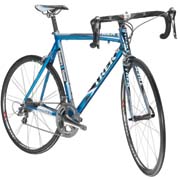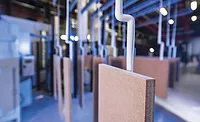Coatings for Your Heat-Sensitive Substrate
The moment has arrived; and as the parts emerge from the oven, they do not look like they are supposed to. The coating looks great, but the parts are deformed. The vice president of sales shakes his head and walks back to his office, and you are left with a major headache - at best.
What happened here is an example of a heat-sensitive substrate that was exposed to a temperature that was too high. In an attempt to provide proper adhesion and the best looking part, the required cure schedule of the coating relative to the substrate is sometimes overlooked in the design stage of a new project. Here, I take a look at some of the important issues to consider when choosing a coating for your substrate.

Heat-Sensitive Substrates
A heat-sensitive substrate can be defined as any substrate that has a change in physical and/or chemical properties when exposed to a certain temperature for a specific period of time. This can include not only heat from the cure oven (including dwell time), but also high temperature from storage in the trunk of a car or in the back of a freight truck, especially in the summer.Some examples of substrates which can be considered heat sensitive include:
- Plastics, including fiberglass, polystyrene, HDPE, ABS,SMC, PBT, nylon, polycarbonate, carbon fiber and polypropylene.
- Wood, such as medium density fiberboard (MDF).
- Preassembled parts that contain any of the above or components (such as electronics and wires).
Typical applications for heat-sensitive substrates include hunting decoys, plastic inserts, cosmetic parts, bicycle frames and vehicle panels.
Coating Criteria and Tests
Because paints and coatings typically are adapted to the substrate, it is important to identify the criteria required when selecting a coating. These criteria should be as objective, realistic and, if possible, defined by empirical data using an ASTM test method.The following are common tests that painted parts are subjected to:
Cross Hatch Adhesion. ASTM test D-3359 measured on a scale from 0B-5B.
Color. Using a colorimeter specifying the light source, angle of the light and the standard deviation range of the readings.
Gloss. A meter reading, typically with a light source at a 20 or 60 degree angle.
Pencil Hardness. ASTM test D-3363 measured in a scale from 6B (soft) to 6H (hard)
Impact test. Dropping rounded weights from a measured distance onto a painted panel and evaluating the result of the impact.
Salt Fog. ASTM test B-117 measuring the overall percentage of rust or "creep" distance from a scribe line.
Coatings Choices
In order to determine the maximum temperature that the substrate can withstand, check with your supplier. Depending on this temperature, there are four types of coatings from which to choose.- Water-based. Air dry or force cured at low temperature.
- Solvent-based. Air dry or some require heat to cure.
- Powder Coat. A few are low temperature bake.
- UV Cured. Typically applied at up to 100 percent solids; the UV light generates some heat.
Air dry is always a safe bet over a heat-sensitive substrate. There are many waterborne coatings that provide excellent properties as well as adhesion to a wide range of substrates. These coatings have the advantage of not "attacking" the substrate and can air dry typically in 15 min to the touch, at 1 mil dry film thickness (DFT). This dry time can be cut in half with a force cure of 10 min at 120°F.
Solvent-based coatings can be limited because they can attack the substrate and alter its properties. In addition, these coatings have much higher VOCs and some have long air dry times or require curing at 160°F (or above) for 15 min or more.
Research and development continues on low bake powder coatings, but currently the choices are limited. In addition, these coatings cannot be air dried and typically require a cure schedule in excess of 250°F.
UV-cured coatings continue to evolve and are growing in popularity and chemistry. It can sometimes be a challenge to apply a 100 percent solids UV coating to your part. Roll coating works well, but it is not adaptable to all part geometries. Rotary atomizers are effective but require a significant capital investment. UV coatings can be sprayed at less than 100 percent solids when cut with water or solvents. Keep in mind that flash-off time (and extra conveyor length) is required to remove the water or solvent prior to curing with the UV light source.
Coatings Usage
Since 1969, Prime Coatings has provided a range of liquid coatings, including UV-cured and specialty coatings. The following are examples of coatings formulated to be compatible with heat-sensitive substrates, while meeting performance requirements. Trek Bicycle in Waterloo, Wis., manufactures many different types of bicycles and has a range of hybrid frames, forks and components that are assembled of carbon fiber and lightweight metal elements. The different expansion coefficients of these assemblies require low temperature curing. Also, the decals used to provide product identity are heat sensitive and if baked at an elevated temperature, can cause a blemish that ruins a Class A surface.Coating systems were developed that enable oven temperatures to be reduced by 60°F and still maintain the full performance parameters.
Foam rubber is another example of a heat-sensitive substrate, which in one case, is used to manufacture collapsible turkey decoys. Prime Coatings worked with Flambeau Corp., Baraboo, Wis., to develop an air dry, waterborne, acrylic emulsion that can be flexible enough for the substrate to be completely folded up and put into a jacket pocket. The coating used on the turkey decoys provides 360-degree flexibility without cracking or loss of adhesion. The acrylic emulsion is air dried and contains UV inhibitors and water resistance for use during the hunting season.
This coating also met the performance requirements for garage door window inserts, which require flexing in order to be removed and reinserted.
In many instances of new product development, the coating and its application -including cure schedule - are not addressed until near the end of the project. It is critical to consider these issues at the time when the substrate is chosen.
Often an existing formulation from your coating supplier is acceptable. But, if changes cannot be made to the substrate, a new formula must be developed, which may require time for lab testing as well as line trials. The impact on your project timeline may leave you with a headache as well as an odd looking part coming out of the oven.
Tom Slavinsky, technical sales, Prime Coatings, Pewaukee, Wis., can be reached at 262-691-1930, ext. 114, or visit www.primecoatings.net.
Sidebar: Coatings for Heat-Sensitive Substrates
Once you have contacted your coatings supplier to determine the maximum temperature that your heat-sensitive substrate can withstand, there are four types of coatings from which to choose, including:- Water-based. Air dry or force cured at low temperature.
- Solvent-based. Air dry or some require heat to cure.
- Powder Coat. A few are low temperature bake.
- UV Cured. Typically applied at up to 100 percent solids; the UV light generates some heat.
Looking for a reprint of this article?
From high-res PDFs to custom plaques, order your copy today!







